Suggestions
Use up and down arrows to review and enter to select.Please wait while we process your payment
If you don't see it, please check your spam folder. Sometimes it can end up there.
If you don't see it, please check your spam folder. Sometimes it can end up there.
Please wait while we process your payment

By signing up you agree to our terms and privacy policy.
Don’t have an account? Subscribe now
Create Your Account
Sign up for your FREE 7-day trial
Already have an account? Log in
Your Email
Choose Your Plan
Individual
Group Discount
Save over 50% with a SparkNotes PLUS Annual Plan!
 payment page
payment page
Purchasing SparkNotes PLUS for a group?
Get Annual Plans at a discount when you buy 2 or more!
Price
$24.99 $18.74 /subscription + tax
Subtotal $37.48 + tax
Save 25% on 2-49 accounts
Save 30% on 50-99 accounts
Want 100 or more? Contact us for a customized plan.
 payment page
payment page
Your Plan
Payment Details
Payment Summary
SparkNotes Plus
You'll be billed after your free trial ends.
7-Day Free Trial
Not Applicable
Renews May 11, 2024 May 4, 2024
Discounts (applied to next billing)
DUE NOW
US $0.00
SNPLUSROCKS20 | 20% Discount
This is not a valid promo code.
Discount Code (one code per order)
SparkNotes PLUS Annual Plan - Group Discount
Qty: 00
SparkNotes Plus subscription is $4.99/month or $24.99/year as selected above. The free trial period is the first 7 days of your subscription. TO CANCEL YOUR SUBSCRIPTION AND AVOID BEING CHARGED, YOU MUST CANCEL BEFORE THE END OF THE FREE TRIAL PERIOD. You may cancel your subscription on your Subscription and Billing page or contact Customer Support at custserv@bn.com. Your subscription will continue automatically once the free trial period is over. Free trial is available to new customers only.
Choose Your Plan
For the next 7 days, you'll have access to awesome PLUS stuff like AP English test prep, No Fear Shakespeare translations and audio, a note-taking tool, personalized dashboard, & much more!
You’ve successfully purchased a group discount. Your group members can use the joining link below to redeem their group membership. You'll also receive an email with the link.
Members will be prompted to log in or create an account to redeem their group membership.
Thanks for creating a SparkNotes account! Continue to start your free trial.
We're sorry, we could not create your account. SparkNotes PLUS is not available in your country. See what countries we’re in.
There was an error creating your account. Please check your payment details and try again.
Please wait while we process your payment

Your PLUS subscription has expired
Please wait while we process your payment
Please wait while we process your payment

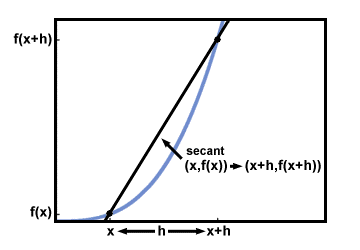
To get the slope of the curve at the point (x, f (x)), let's now draw the tangent line at (x, f (x)).
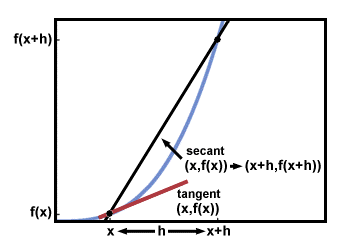
Recall that the tangent to the graph has the same slope as the graph at the point of tangency. Therefore, finding the slope of the graph at (x, f (x)) is the same as finding the slope of the tangent line we have just drawn.
Now comes a crucial step. Consider what happens to the secant line as h, the distance between the two points on the x-axis, is made progressively smaller:
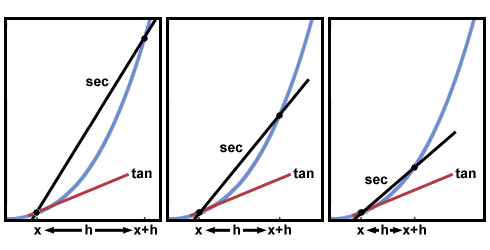
It appears now that as h gets smaller, the secant line looks more and more like the tangent line, which means that the slope of the secant is getting closer and closer to the slope of the tangent. This suggests that if we could make h arbitrarily small, the slope of the secant would get arbitrarily close to the slope of the tangent. Using limits, this idea could be represented as:
mtangent =  (msecant) (msecant) |
Substituting in the difference quotient for the slope of the secant yields
mtangent =   |
Since the slope of the tangent is the same as the slope of the graph at the
point of tangency, we can say:
slope off at(x, f (x)) =   |
This is one of the central ideas of all of calculus. The limit of the difference quotient is
such an important expression that it is given a name, the derivative, and is
represented by "f'(x)". Thus, we can say:
f'(x) =   |
is the derivative of the function f with respect to x.
The derivative gives the slope of the curve (also the slope of the tangent to the curve) at the point (x, f (x)). The derivative itself is also a function, because for every x value that it is given, it returns a value that is equal to the slope of the tangent to f at x.
An alternate notation for the derivative is the Leibniz Notation, when
 means "the derivative of whatever follows with the respect to x". Thus,
means "the derivative of whatever follows with the respect to x". Thus,
 means the derivative of f with respect to x, or
f'(x) =
means the derivative of f with respect to x, or
f'(x) =  means the derivative of y with respect to x. Since y
commonly means
f (x), this is usually the same as
means the derivative of y with respect to x. Since y
commonly means
f (x), this is usually the same as
  f f or f'(x) or f'(x) |
A function f is said to be differentiable at x = a if f'(a) exists. In other words, a function is differentiable at x = a if
  |
exists.
Intuitively, for a function to be differentiable, it needs to be both continuous and "smooth". What is meant by "smooth" is that there are no sharp turns in the graph.
Tangent lines can only be drawn to graphs in places where they are both continuous and smooth, as shown below:
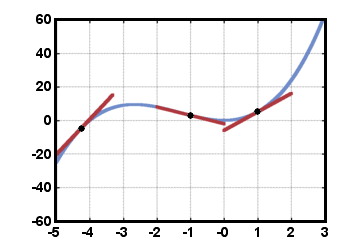
One example of a function that is continuous but not "smooth" throughout is the absolute value function. Consider f (x) =|x|. This function is continuous, but has a sharp "corner" at x = 0:
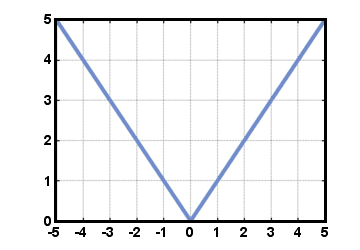
The function f (x) =|x| is not differentiable at x = 0 because the sharp corner makes it impossible to draw a single tangent line, since there is no defined slope there. Thus, f'(0) does not exist for this function.
Note that any differentiable function must also be continuous, since it is impossible to have a defined slope at a point of discontinuity. However, not all continuous functions are differentiable. An example of this was seen with the absolute value function.
Please wait while we process your payment

